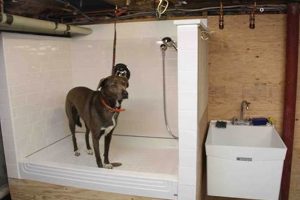A constructed assistive device provides canines with a gentle incline to access elevated surfaces such as beds. This structure mitigates the need for jumping, reducing stress on joints and potentially preventing injuries. For instance, a set of wooden planks, securely fastened and covered with carpet, allows smaller or aging dogs to reach a higher sleeping area with ease.
The implementation of such a solution offers significant advantages, particularly for breeds predisposed to skeletal issues, overweight animals, or those recovering from surgery. Historically, makeshift solutions, such as using stacked books or cushions, have been employed. However, a specifically designed and built alternative ensures greater stability and safety for the animal. The accessibility granted improves the dog’s quality of life and minimizes the risk of accidents.
The following sections will explore materials selection, construction techniques, and design considerations essential for crafting a functional and aesthetically pleasing aid, ensuring a comfortable and safe experience for canine companions.
Essential Considerations for Constructing an Incline for Canine Bed Access
The creation of an incline necessitates careful planning and execution to ensure the structure’s efficacy and the animal’s safety. Adherence to these guidelines will contribute to a positive outcome.
Tip 1: Material Selection: Opt for durable, non-toxic materials. Untreated wood or plywood forms a stable base. Avoid particleboard, which can off-gas formaldehyde and degrade quickly with moisture exposure. Consider carpet or textured rubber for the ramp surface to provide traction.
Tip 2: Angle of Inclination: Determine the appropriate slope based on the dog’s size and physical condition. A shallower angle is preferable for smaller dogs or those with mobility issues. A steeper incline can present challenges and increase the risk of slips and falls.
Tip 3: Structural Integrity: Ensure the framework is robust and capable of supporting the dog’s weight. Reinforce joints with screws and wood glue. Regularly inspect the structure for signs of weakness or deterioration.
Tip 4: Surface Traction: A smooth surface poses a significant hazard. Securely attach carpet, rubber matting, or non-slip tape to the ramp’s surface. Ensure the chosen material is securely fastened and free from loose edges or tripping hazards.
Tip 5: Ramp Width: The width should accommodate the dog’s gait comfortably. A narrower ramp may cause instability. A wider ramp provides a greater margin of error and reduces the likelihood of the dog stepping off the edge.
Tip 6: Height Adjustment: If the bed height is subject to change, consider a design that allows for adjustability. This may involve a telescoping mechanism or a series of interlocking segments.
Tip 7: Edge Protection: Install side rails or bumpers along the edges of the ramp to prevent accidental falls. These barriers should be of sufficient height to contain the dog without impeding its movement.
The careful application of these principles will yield a durable, safe, and effective structure that enhances the canine companion’s accessibility and overall well-being.
Subsequent sections will address aesthetic considerations and integration within the home environment.
1. Stability
Structural integrity forms the cornerstone of a functional canine assistive device. Without adequate stability, the entire purpose is negated, transforming a helpful tool into a potential hazard. The connection between a dog’s access to raised surfaces and this attribute is direct and consequential. A structure built with substandard materials or inadequate joinery introduces a high risk of collapse. This risk intensifies when the canine is elderly, infirm, or of significant mass. Consequently, the device becomes detrimental rather than beneficial.
Consider a scenario involving a ramp constructed from thin plywood and unsecured supports. Under the weight of a medium-sized dog, the ramp could buckle, leading to injury. Conversely, a well-engineered design employing reinforced framing and properly spaced supports distributes weight evenly, ensuring unwavering stability. Another example involves surface materials. Loose carpeting, instead of providing traction, might slide off a structurally weak ramp, causing a fall. In each scenario, the lack of inherent structure transforms the attempt at assistance into a risky endeavor.
The correlation between stability and safety is paramount. An unsteady surface not only deters usage, but also poses a direct threat to the canine. Proper material selection, sturdy construction, and diligent weight distribution considerations are critical to creating a stable structure. A focus on stability is an investment in safety. Any oversight compromises the dogs physical integrity and negates the potential benefits. A stable device supports the canine instead of endangering it.
2. Incline angle
The incline angle is a critical determinant of the functionality and safety of a canine access device. It directly influences the ease with which a dog can ascend and descend. A steep angle increases the physical strain on the animal, potentially exacerbating existing joint conditions or leading to new injuries. Conversely, an excessively shallow angle extends the length of the ramp, requiring more space and potentially becoming unwieldy within a living environment. The proper selection of this angle necessitates careful consideration of the dog’s size, age, physical condition, and breed characteristics. For instance, a dachshund, prone to intervertebral disc disease, will require a much shallower angle than a young, agile Labrador Retriever.
An unsuitable incline angle directly compromises the usefulness of such a structure. If too steep, the animal may refuse to use the device, rendering it pointless. If too shallow, the extended length can make the device impractical within the confines of a typical home. Moreover, an incorrect angle can lead to instability. If the dog is forced to exert excessive effort to climb, it may be more prone to slipping or losing its balance, particularly if the ramp surface lacks sufficient traction. The construction process must therefore prioritize precise angle measurement and adherence to the specific needs of the canine user. The formula used to calculate the incline is based on the height of the bed and the desired angle of the ramp. Trigonometry calculations should be implemented.
In summation, the incline angle is not merely a geometric parameter; it is a pivotal design element that directly impacts the safety, efficacy, and usability of a canine assistive device. Proper angle selection requires a thorough assessment of the dog’s physical capabilities and environmental constraints. Neglecting this element can result in a design that is not only ineffective but also potentially harmful. The construction phase should meticulously adhere to angle measurements, ensuring the structure provides safe and convenient access to raised surfaces.
3. Surface Traction
Surface traction is a crucial element in the design and functionality of canine assistive devices intended to aid in accessing raised surfaces. Its absence or inadequacy can negate the benefits of the structure and introduce significant safety hazards. The following facets outline the importance of appropriate surface treatment.
- Material Selection and Coefficient of Friction
The choice of material directly impacts the degree of friction between the dog’s paws and the ramp surface. Materials with a high coefficient of friction, such as textured rubber or loop-pile carpet, provide a secure grip. Conversely, smooth surfaces like polished wood or vinyl offer minimal resistance and increase the risk of slipping. The appropriate material must be selected based on the canine’s weight, gait, and any pre-existing mobility limitations. For instance, an older dog with arthritis requires a surface offering exceptional grip to minimize joint strain.
- Surface Texture and Paw Contact
The texture of the ramp surface directly affects the area of contact between the dog’s paws and the device. Deeply textured surfaces, such as ribbed rubber, provide multiple points of contact, enhancing grip and stability. Flat, smooth surfaces offer less contact and are more prone to slippage, particularly when the surface is wet or dusty. A surface with excessive texture, however, may irritate sensitive paws or trap debris, necessitating regular cleaning and maintenance.
- Secure Attachment and Durability
The surface material must be securely attached to the ramp’s underlying structure to prevent shifting or detachment. Loose carpeting or poorly adhered rubber mats create tripping hazards and compromise the overall stability of the device. Adhesives, staples, and tacks should be appropriately selected for the chosen materials and applied with precision to ensure a durable and long-lasting bond. Regular inspections are necessary to identify and rectify any signs of wear, tear, or detachment.
- Environmental Conditions and Maintenance
The effectiveness of surface traction can be significantly affected by environmental conditions. Wet or icy conditions reduce friction and increase the risk of falls. Indoor ramps are less susceptible to these conditions, but dust, hair, and other debris can still diminish grip. Regular cleaning with appropriate cleaning agents is essential to maintain optimal traction. Outdoor ramps require more frequent cleaning and may necessitate the use of weather-resistant materials to prevent deterioration.
The integration of appropriate surface traction is not merely a cosmetic consideration; it is a fundamental safety requirement for the successful implementation of any canine assistive device. The selection of materials, textures, and attachment methods must be carefully considered in relation to the dog’s individual needs and the environmental conditions in which the device will be used. Diligent maintenance is also essential to ensure the continued effectiveness of the surface and prevent potential accidents.
4. Width sufficiency
Width sufficiency is a critical design parameter in the construction of canine assistive devices, directly influencing the stability, safety, and overall usability of these structures. Inadequate width can compromise the dog’s balance, increase the risk of falls, and deter usage, rendering the device ineffective. Therefore, a comprehensive understanding of the factors influencing width requirements is essential for successful creation.
- Breed and Size Considerations
The breed and size of the canine are primary determinants of appropriate ramp width. Larger breeds, such as Great Danes or Saint Bernards, require significantly wider ramps than smaller breeds like Chihuahuas or Dachshunds. The width should accommodate the dog’s natural gait and stance, allowing ample room for comfortable and confident movement. A ramp that is too narrow forces the dog to alter its gait, potentially leading to instability and an increased risk of stepping off the edge.
- Gait and Mobility Limitations
A dog’s gait and any existing mobility limitations also influence width requirements. Dogs with arthritis, hip dysplasia, or other orthopedic conditions may have a wider or less stable gait. Ramps for these animals should be sufficiently wide to provide additional support and stability. A wider surface allows the dog to adjust its stance and maintain balance more easily, reducing the risk of falls and injuries. Observation of the dog’s natural movement is crucial in determining the appropriate width.
- Ramp Angle and Height
The angle and height of the ramp also affect the required width. Steeper ramps and higher elevations demand greater width to provide sufficient stability. As the incline increases, the dog’s center of gravity shifts, making it more prone to tipping or losing balance. A wider ramp offers a larger margin of error and reduces the likelihood of accidental falls. Similarly, longer ramps require greater width to ensure the dog remains within the boundaries of the surface during ascent or descent.
- Edge Barriers and Confidence
The presence or absence of edge barriers also impacts width considerations. Ramps with side rails or bumpers can be narrower than those without, as the barriers provide an added measure of safety and prevent the dog from stepping off the edge. However, even with edge barriers, the ramp should be sufficiently wide to allow comfortable movement and prevent feelings of confinement. The overall goal is to create a structure that instills confidence in the dog and encourages its consistent use.
In conclusion, width sufficiency is not a static parameter but a dynamic element that must be carefully considered in relation to the individual needs of the canine and the specific characteristics of the assistive device. An adequately wide ramp promotes stability, reduces the risk of falls, and encourages consistent use, thereby maximizing the benefits for the animal. Neglecting this aspect can render the entire structure ineffective or even dangerous.
5. Material safety
Material safety constitutes a primary concern in the construction of canine assistive devices. The selection of appropriate materials mitigates potential harm to the animal, ensuring the structure promotes well-being rather than posing a threat. Attention to the composition and treatment of construction materials is paramount for responsible construction.
- Toxicity of Wood Treatments and Finishes
Many wood treatments, preservatives, and finishes contain volatile organic compounds (VOCs) and other toxins that can be harmful to canines upon ingestion or inhalation. Creosote, pentachlorophenol, and certain oil-based paints are examples of substances that should be avoided. Opting for non-toxic, water-based finishes or leaving the wood untreated, where appropriate, minimizes the risk of chemical exposure. Sealants should also be scrutinized for potential toxicity; those labeled “pet-safe” are preferable.
- Potential for Splintering and Abrasions
The type of wood used in ramp construction directly impacts the potential for splintering, which poses a physical hazard to the dog. Softwoods, such as pine, are more prone to splintering than hardwoods like maple or oak. Regardless of the wood type, careful sanding and smoothing of all surfaces are essential to eliminate sharp edges and prevent abrasions. Regularly inspecting the ramp for splinters and promptly addressing any that are found is crucial for maintaining a safe environment.
- Carpet Fiber Composition and Allergen Potential
If carpet is used to provide traction, the fiber composition should be carefully considered. Certain synthetic fibers, such as nylon or olefin, may trigger allergic reactions in sensitive animals. Natural fibers, such as wool or cotton, are generally less allergenic but may be more susceptible to moisture damage and bacterial growth. Thorough cleaning and regular vacuuming are necessary to minimize allergen accumulation, regardless of the carpet fiber type. Natural rubber may be a good alternative with a high friction coefficient.
- Hardware Material and Secure Fastening
The hardware used to assemble the ramp, including screws, nails, and bolts, should be made of rust-resistant materials such as stainless steel or galvanized steel. This prevents corrosion and the potential for hardware failure. Furthermore, all fasteners should be securely embedded within the wood to eliminate sharp protrusions that could injure the dog. Regular inspection of hardware is critical to ensure ongoing structural integrity and prevent loosening or detachment.
Consideration of these material safety aspects is integral to responsible canine access device construction. The careful selection of non-toxic materials, diligent surface preparation, and secure assembly techniques contribute to a safer and healthier environment for the animal. Neglecting these principles can transform a well-intentioned assistive device into a source of potential harm. Therefore, prioritization of material safety is essential for creating a device that truly enhances the canine companion’s quality of life.
6. Height adequacy
Height adequacy in the context of canine assistive devices refers to the precise vertical dimension required for a ramp to effectively bridge the gap between the floor and the elevated surface, typically a bed. It’s a foundational element in the design and construction, influencing both usability and safety. An incorrectly sized structure undermines its intended purpose.
- Bed Height Measurement and Compensation
Accurate measurement of the target bed’s height is paramount. This measurement serves as the baseline for determining the ramp’s overall length and incline. Failure to account for variations in bed frame thickness, mattress height, or the presence of bedding can result in a ramp that is either too short, rendering it unusable, or too tall, creating an unnecessarily steep and potentially hazardous incline. Adjustable ramp designs offer a solution to accommodate slight variations.
- Incline Angle and Resultant Ramp Length
The desired incline angle directly correlates with the required ramp length to achieve adequate height. A shallower incline necessitates a longer ramp, while a steeper incline requires a shorter one. However, excessively steep inclines pose significant challenges for canines, particularly those with mobility limitations. Thus, a balance must be struck between spatial constraints and the animal’s physical capabilities. Trigonometric calculations are often employed to determine optimal ramp length based on bed height and desired incline.
- Structural Stability and Support Requirements
Height adequacy also influences the structural demands placed upon the ramp. Taller ramps require more robust support systems to prevent sagging or collapse under the dog’s weight. This may necessitate the use of thicker materials, additional support beams, or strategically placed legs. The ramp’s design must ensure that the structure remains stable and secure, even under maximum load, to prevent accidents and injuries.
- Accessibility for Canines of Varying Size
While the ramp is primarily designed for a specific dog and bed height, consideration should be given to potential variations in canine users. If multiple dogs of different sizes will utilize the ramp, the height should be adequate for the smallest or most mobility-challenged animal. Compromises may be necessary to accommodate a range of users, while still maintaining safety and usability for all.
In summary, height adequacy is not a simple linear measurement but rather a complex interplay of factors that contribute to the overall effectiveness of a canine assistive structure. It necessitates careful measurement, consideration of incline angles and structural requirements, and awareness of the dog’s individual needs. A well-executed ramp, appropriately sized for its intended purpose, can significantly enhance a canine’s quality of life and promote long-term well-being.
7. Edge barriers
Edge barriers, in the context of a constructed canine assistive device designed for bed access, serve as a critical safety feature, directly mitigating the risk of accidental falls. Their presence establishes a physical boundary, preventing the dog from inadvertently stepping or slipping off the sides of the ramp during ascent or descent. The absence of such barriers introduces a heightened potential for injury, particularly for canines with impaired vision, limited mobility, or a tendency towards unsteady gait. A rudimentary example underscores this point: A ramp constructed from a smooth plank of wood, lacking any form of edge protection, presents a significantly increased hazard compared to an identical ramp featuring raised side rails. The practical significance of this distinction is evident in reduced incidence of falls and associated injuries.
The implementation of edge barriers necessitates careful consideration of material selection and design. Barriers should be constructed from durable, non-toxic materials that can withstand the dog’s weight and potential impact. The height of the barrier must be sufficient to provide adequate containment without impeding the animal’s movement. Furthermore, the design should eliminate any sharp edges or protrusions that could cause injury. Real-world applications often showcase variations in design, ranging from simple wooden rails to padded bumpers, each tailored to the specific needs and characteristics of the canine user. Some designs incorporate integrated traction surfaces along the edges, further enhancing safety and stability.
In summary, edge barriers represent an indispensable component of a safe and effective assistive device for canine bed access. Their presence significantly reduces the risk of accidental falls and associated injuries, thereby promoting the animal’s well-being. While the specific design and materials may vary, the fundamental principle of providing a secure boundary remains paramount. Overlooking this aspect compromises the integrity of the structure and potentially endangers the canine. Prioritizing the inclusion of robust and appropriately designed edge barriers is essential for responsible construction.
Frequently Asked Questions
The following questions address common inquiries regarding the construction and utilization of structures designed to assist canines in accessing elevated sleeping surfaces. The information provided seeks to clarify concerns and misconceptions surrounding these devices.
Question 1: What constitutes the optimal incline angle for a canine access ramp?
The optimal incline angle varies depending on the canine’s size, age, and physical condition. Generally, a shallower angle, ranging from 18 to 26 degrees, is recommended for smaller breeds, senior dogs, or those with orthopedic issues. Steeper angles increase the risk of joint strain and potential injury.
Question 2: Which materials are most suitable for constructing a safe and durable access ramp?
Durable hardwoods, such as maple or oak, provide a stable and long-lasting base. Non-toxic, water-based finishes are preferable to solvent-based alternatives. The ramp surface should be covered with a material offering adequate traction, such as loop-pile carpet or textured rubber. Fasteners should be rust-resistant to prevent corrosion.
Question 3: How can structural stability be ensured during construction?
Employ robust framing techniques, utilizing appropriately sized lumber and secure joinery methods, such as screws and wood glue. Reinforce high-stress areas with additional supports. Regularly inspect the structure for signs of weakness or deterioration, and promptly address any issues that arise.
Question 4: What width is recommended for a canine access ramp?
The ramp width should accommodate the canine’s natural gait, allowing for comfortable and confident movement. A minimum width of 16 inches is generally recommended for smaller breeds, while larger breeds may require widths of 20 inches or more. Adjustments may be necessary based on individual animal’s size and mobility.
Question 5: How can the risk of splinters or abrasions be minimized?
Thoroughly sand all wooden surfaces to eliminate sharp edges and splinters. Apply a smooth, durable finish to protect the wood and prevent further splintering. Regularly inspect the ramp for any signs of wear or damage, and promptly repair or replace compromised components.
Question 6: Are edge barriers necessary for a canine access ramp?
Edge barriers significantly enhance safety by preventing accidental falls. While not strictly mandatory, they are highly recommended, particularly for senior dogs, visually impaired animals, or those with balance issues. Barriers should be of sufficient height to contain the dog without impeding its movement.
The information presented provides guidelines for the construction and utilization of these structures. Prioritizing safety and tailoring the design to the specific needs of the canine user are essential considerations.
The subsequent section will address the integration of access ramps within a home environment and aesthetic considerations.
Concluding Remarks on Canine Bed Access Construction
This exploration of diy dog bed ramp construction has underscored the critical importance of safety, stability, and tailored design. Material selection, incline angle, surface traction, width sufficiency, material safety, height adequacy, and edge barriers all demand careful consideration. The goal is to craft a structure that reliably assists canine companions in accessing elevated surfaces, mitigating potential risks associated with jumping.
The successful implementation of these principles translates into a tangible improvement in a dog’s quality of life, particularly for aging or mobility-impaired animals. Diligent application of the guidelines outlined will ensure the creation of a safe, functional, and aesthetically integrated assistive device. Prudent and informed construction contributes to the well-being and longevity of beloved animal companions.







